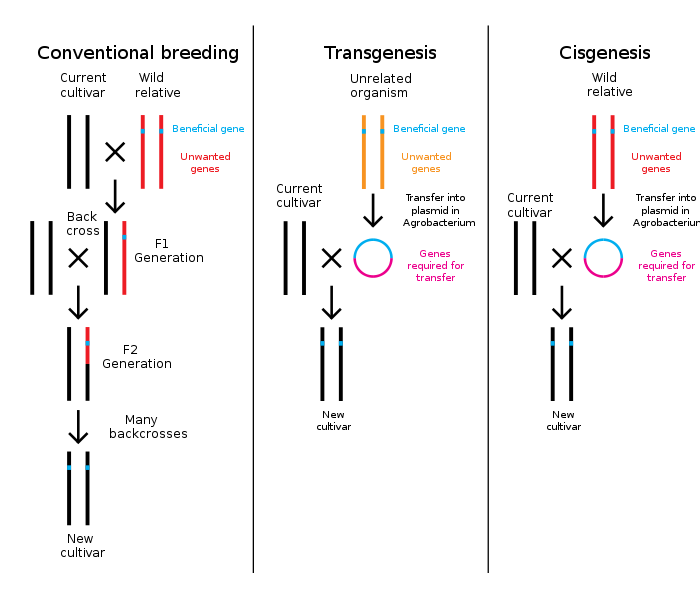- Cisgenesis
-
Potatoes after treatment with Phytophthora infestans. The normal potatoes have blight but the cisgenic potatoes are healthy

Cisgenesis, sometimes also called Intragenesis, is a product designation for a category of genetically engineered plants. A variety of classification schemes have been proposed [1], that order genetically modified organisms based on the nature of introduced genotypical changes rather than the process of genetic engineering.
Cisgenesis (from "same" and "beginning") is one term for organisms, which have been engineered using a process by which genes are artificially transferred between organisms that could otherwise be conventionally bred.[2][3] Unlike in transgenesis, genes are only transferred between closely related organisms.[4] The term was first used in a PhD thesis by Jan Schaart of Wageningen University in 2004, discussing making strawberries less susceptible to Botrytis cinerea.[5]
In Europe currently this process is governed by the same laws as transgenesis but researchers at Wageningen University in the Netherlands feel that this should be changed and regulated in the same way as conventionally bred plants. However, other scientists, writing in Nature Biotechnology have disagreed writing, "Although lowering regulatory hurdles may increase profits in the short term, it could place the long-term potential of improved agriculture through GE in jeopardy. We would prefer to see plant molecular biologists focus their attention on developing more sophisticated methodologies such as a targeted gene knock-in strategy or genomics-assisted breeding rather than on schemes to evade regulatory mechanisms with products that are still generated by relatively crude transgenic technology."[6]
Cisgenesis and transgenesis use artificial gene transfer, which results in far less change to an organism's genes compared to mutagenesis which was widely used before genetic engineering was developed.[7]
Some people believe that cisgenesis should not face as much regulatory oversight as genetic modification through transgenesis. Cisgenesis differs from conventional breeding because it can potentially create new varieties of crops more quickly and cheaply and only selected beneficial genes are transferred and not other genes nearby on the chromosome. In conventional breeding multiple backcrosses must be performed, each taking at least several months, to create a new cultivar. Cisgenesis can achieve the same results in a fraction of the time. One application of cisgenesis is to create blight resistant potato plants by taking resistance from wild varieties and transferring them into high yielding varieties.[8]
Related classification scheme
A related classification scheme proposed by Kaare Nielsen is:[9]
Source of genetic modification Genetic variability via conventional breeding Genetic distance Intragenic Within genome Possible Low Famigenic Species in the same family Possible Linegenic Species in the same lineage Impossible Transgenic Unrelated species Impossible Xenogenic Laboratory-designed genes Impossible High Diagram
.
References
- ^ Nielsen, K. M. (2003). "Transgenic organisms—time for conceptual diversification?". Nature Biotechnology 21 (3): 227–228. doi:10.1038/nbt0303-227. PMID 12610561.
- ^ Cisgenesis definitions cisgenesis.com
- ^ Schubert, D.; Williams, D. (2006). "'Cisgenic' as a product designation". Nature biotechnology 24 (11): 1327–1329; author 1329 1331–1329. doi:10.1038/nbt1106-1327. PMID 17093469.
- ^ How the humble potato could feed the world Deborah MacKenzie, New Scientist No2667 2 August 2008 30-33
- ^ http://www.cababstractsplus.org/abstracts/Abstract.aspx?AcNo=20053043531
- ^ Schubert, D.; Williams, D. (2006). "'Cisgenic' as a product designation". Nature biotechnology 24 (11): 1327–1329; author 1329 1331–1329. doi:10.1038/nbt1106-1327. PMID 17093469.
- ^ Schouten, H.; Krens, F.; Jacobsen, E. (2006). "Do cisgenic plants warrant less stringent oversight?". Nature biotechnology 24 (7): 753. doi:10.1038/nbt0706-753. PMID 16841052.
- ^ Jacobsen, E.; Schouten, H. J. (2008). "Cisgenesis, a New Tool for Traditional Plant Breeding, Should be Exempted from the Regulation on Genetically Modified Organisms in a Step by Step Approach". Potato Research 51: 75–88. doi:10.1007/s11540-008-9097-y. Free version
- ^ Nielsen, K. M. (2003). "Transgenic organisms—time for conceptual diversification?". Nature Biotechnology 21 (3): 227–228. doi:10.1038/nbt0303-227. PMID 12610561.
Genetic engineering Genetically
modified
organismsMammalsMaizePotatoAmfloraRiceSoybeanRoundup Ready soybean · Vistive GoldTomatoFish tomato · Flavr SavrCottonBt Cotton · Roundup Ready cottonOtherFishGlofish · SalmonBacteria and virusesProcesses TypesUses In agricultureIn humans and diagnosticsGene therapy · Genetic enhancementIn researchRelated articles Transgene · Detection of genetically modified organisms · Genetic pollution · Eugenics · Genetic engineering in fiction · Reverse transfectionSimilar fields Biology · Genetics · Biotechnology · Bioethics Categories:- Genetics stubs
- Genetics
Wikimedia Foundation. 2010.


